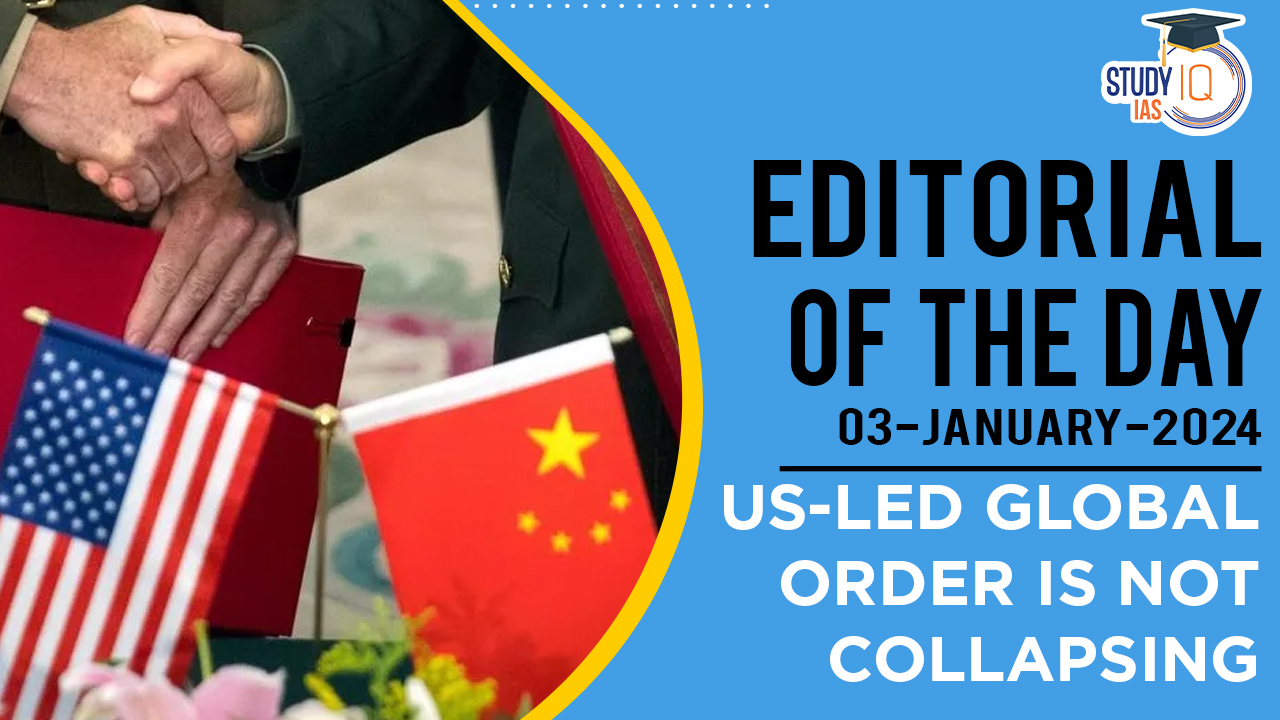Table of Contents
Context: The challenges facing the US-led world order stem from global conflicts, China’s ascendancy, and internal divisions within the US
US-led Global Order Introduction
The US-led global order, shaped by America’s economic and military dominance, promotes democracy, free markets, and security alliances. It has been central to global governance and conflict resolution since World War II.
We’re now on WhatsApp. Click to Join
Arguments Related To US-led Global Order
| Arguments Favouring Decline | Arguments Against Decline |
| Military Stalemates and Conflicts: The impasse in Ukraine and Middle East conflicts challenge US/Western military and diplomatic influence. | Historical Resilience: The West has consistently adapted to crises, maintaining its democratic and capitalist institutions. |
| Rising Eastern Powers: Chinese assertiveness and Eastern nations’ growing confidence signal a shift in power, reducing Western dominance. | Dominant Position: The U.S. controls 24% of global GDP, leads in tech and knowledge production, and its culture and institutions attract global interest. |
| Internal Political Turmoil: Political polarisation in the U.S. potentially weakens the West’s global standing. | Desire for Westernization: In countries like Russia and China, factions advocate for integration with the Western order, signifying its ongoing appeal. |
| Economic Indicators: The declining GDP share of G7 nations, especially Europe, suggests the West’s relative economic decline. | Confrontation with China: China’s economic slowdown and demographic challenges suggest it won’t surpass the U.S. economy soon, maintaining Western economic leadership. |
| Challenges within Non-Western Institutions: Discord among BRICS and SCO members, especially India and China, indicates a lack of unified opposition to Western dominance. |
India’s Stance on Global Order
- Strategic Partnership with the West: India views its relationship with Western countries, particularly the US, as a critical component in elevating its position in global affairs.
- Balancing Relations: Despite occasional disagreements, India maintains a productive engagement with the West, recognizing the benefits of this relationship.
- Desire for Stability: India does not wish for the decline of the US-led global order, nor does it seek to replace the US with China as the dominant power in Asia.
- National Security Considerations: The partnership with Western nations is seen as vital for addressing India’s major security challenges.
- Economic and Technological Ties: India values its economic and technological ties with Western countries and seeks to advance these partnerships.
- Pragmatic Approach: India’s approach is pragmatic, focusing on advancing its interests and enhancing its global standing rather than engaging in ideological crusades against the West.


 Indus Water Treaty 1960 Suspended by Ind...
Indus Water Treaty 1960 Suspended by Ind...
 5 Years of SVAMITVA Scheme and Its Benef...
5 Years of SVAMITVA Scheme and Its Benef...
 Places in News for UPSC 2025 for Prelims...
Places in News for UPSC 2025 for Prelims...





















